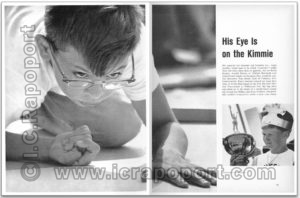MARBLE CHAMPIONSHIP
(July 1961)
My photographs of Fidel Castro and Marilyn Monroe for Paris Match gave me entrée into the prestigious Time-Life Publications. LIFE and TIME were particularly choosy as to who should represent them out in the world, and it was well known that working for LIFE magazine was the top of the line for a photojournalist. I had a hard time breaking into that rarefied air, but there was one Time-Life publication with an easygoing, red-nosed picture editor, Sports Illustrated’s Buddy Bloodgood. He saw beyond inexperience and was willing to give a kid a break.
I had met Magnum photographer Bruce Davidson in March of 1958 at the funeral of W C Handy, a Negro musician and composer known famously for his “St Louis Blues.” Without press credentials, I was handicapped to get the best vantage points to shoot the events in Harlem. I rode the subway down from 125th Street to Life magazine in Rockefeller Center with Bruce who encouraged me to see Life Editor, Ruth Lester. Ms. Lester was the Contributions Editor. Her main job was to review every photograph sent in from the public to see if any were worthy of printing on the Miscellany page in the back of the magazine. Her other job was to be Life’s ‘gatekeeper,’ meeting with photographers interested in selling stories, photographs or looking for assignments (an almost impossible dream for most).
Ruth Lester took my film from the Handy funeral and replaced it with new film and had the rolls developed and processed by the Life laboratory, OA, On Approval. My photos were nothing compared to Bruce Davidson’s who had several pages of really great shots from the Harlem event. But, my contact with Ruth paid off anyway. After returning a number of times to her small office stacked with thousands of contributions from people all over the world, she told me how I shouldn’t hold out too much hope in seeing the busy Dick Pollard, Life’s Picture Editor. Not yet anyway. In the meantime, had I had a meeting with Sports Illustrated Photo Editor, George (Buddy) Bloodgood? I hadn’t, and he was a lot easier to see than Mr. Pollard. Ruth called down to Buddy on the 22nd Floor and, since I was in the building, he agreed to meet me immediately.
I hurried down to his office and met this red-faced, red-haired Irishman. Behind his desk was a bulletin board with photographs, snap shots actually, of most of the photographers who worked for S.I. in crazy attitudes, nutty poses, attempting feats their subjects were great at and, of course they, not so much.
Buddy looked through my portfolio and was impressed with my ‘eye’. He told me right up front that I would never make it as a sports photographer, that I didn’t have the requisite passion for sports. I tried to tell him he was wrong, that I loved sports even though I didn’t have a single photo of a sports event in my portfolio.
“What’s your favorite sport and team?” He asked me.
“The Yankees,” I answered.
“When was the last Yankee game you went to?”
“A few years ago, with my Dad,” I told him and then stopped, realizing what he had just proved. I was not a dedicated sports fan; I was not interested in shooting pictures of sports – until right then, of course. I was crushed.
“But you take really great pictures of people. Human interest stuff,” Buddy said closing my portfolio. “I have a need for that – most of my sports photographers are not interested or can’t even shoot people unless they’re running, jumping or skiing.”
Then, uncapping a bottle of Jameson’s Irish whiskey, he said, ‘You can sure shoot people’ and poured me a shot glass of whiskey, right there, in his office, and then a second glass. I took it as a sort of test. If I could stand up and walk out of there, I was ready to shoot for Buddy Bloodgood.
By summertime I hadn’t heard from Buddy but at the beginning of July of 1961 he called and sent me out to Wildwood, New Jersey to cover the 37th National Marbles Tournament. Contrary to what he had told me earlier, he was actually giving me a “sports” assignment. Arthur Godfrey was the Master of Ceremonies and would “crown” the winners, Augustus “Ace” Millen and Anita Danyluk. My job was to capture the intensity of the contest as S.I. knew the potential of seeing the competitive spirit of youth as the early beginnings of adult sports. Whew!
It didn’t take me long to see that the competitive spirit was plainly apparent.
Buddy Bloodgood’s instincts proved correct and S.I. published two pages on the story Marbles Championship the success of which led to a second assignment the following weekend. Most important though was that I had been published in TIME-LIFE publication which would validate me as a working photojournalist in national American publications.
More importantly, however, is the fact that this new working relationship with Buddy would bring me to the most notable assignment of my entire career: My Day With Joe Pilates for Sports Illustrated – illustrating a marvelous article written by Robert “Bob” Wernick.
